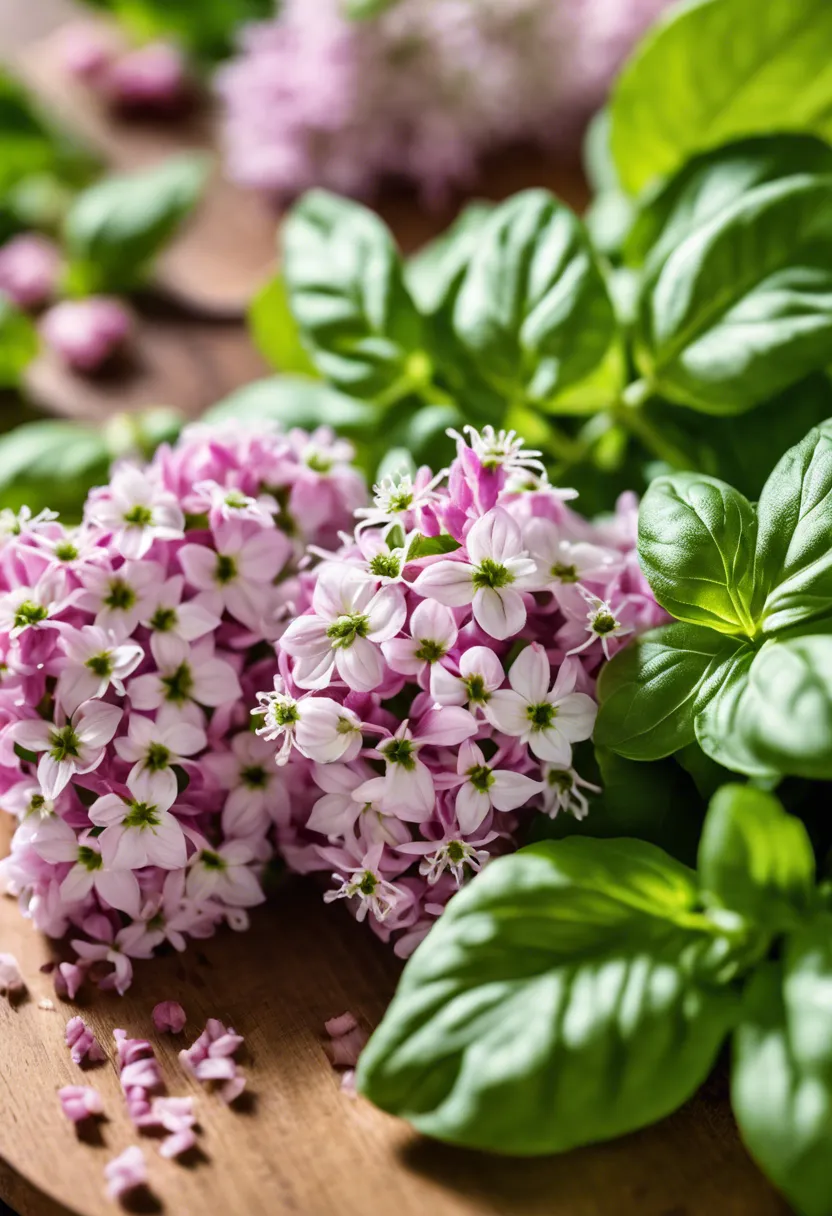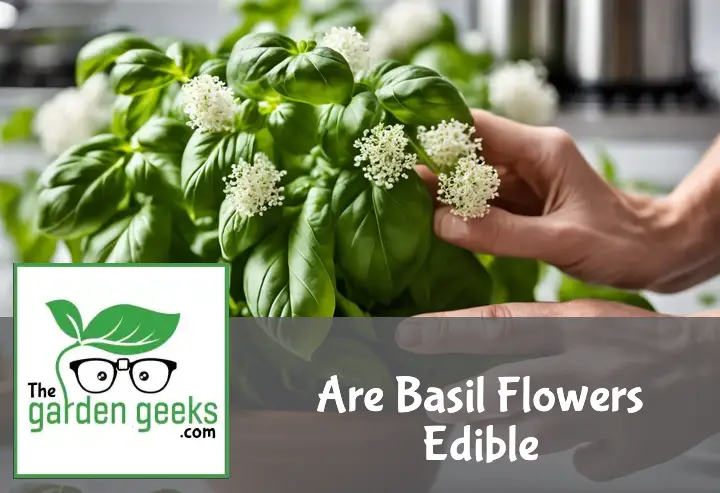Ever had a moment of panic when you see your beloved basil plant sprouting flowers? You might have thought, “Oh no, is my basil going to seed?” Well, let me tell you a secret. Those little blossoms are not just pretty to look at but also pack a punch in the flavor department. So, the big question here is, Are Basil Flowers Edible?
Well, let’s dive into this topic and bring some light to this somewhat under-considered aspect of our favorite herb. Keep reading about ‘Are Basil Flowers Edible?’ and discover how these tiny gems can add an unexpected twist to your culinary adventures!
Key Takeaways
- Yes, basil flowers are edible and can be used in various dishes.
- They have a milder flavor compared to the leaves, but still retain a hint of basil taste.
- Basil flowers can be used fresh or dried in salads, soups, pasta, and drinks.
- Consuming them also provides health benefits as they contain essential oils and antioxidants.
- However, allowing the plant to flower may reduce leaf production.

What are Basil Flowers?
When your basil plant starts sprouting tiny blooms, it’s a sign it’s moving to the next phase of its life. These basil flowers edible wonders are not just pretty; they mark a pivotal moment in the growing basil journey. As we dive deeper, we’ll explore their unique characteristics and how different types of basil influence their flowering. Plus, tips on harvesting basil flowers will ensure you make the most out of every bloom.
Description of Basil Flowers
Basil flowers are small but mighty, often surprising gardeners with their delicate appearance. They typically emerge in clusters at the top of the plant, adding a splash of color amidst the green leaves. The appearance of basil flowers varies slightly among species, yet they commonly share a soft, pastel hue that can range from white to pink or light purple. Their size is modest, but what they lack in dimensions, they make up for in charm and fragrance.
Identifying these blooms isn’t tricky; look for slender stems supporting petite florets that seem to dance lightly in the breeze. This characteristic sets them apart from other herb flower features, making them not only a culinary delight but also a visual treat in any garden.
Varieties of Basil and Their Flowers
Not all basil is created equal, especially when it comes to their flowers. The variety greatly influences both the appearance and timing of flowering. For instance, Sweet basil flowers tend to be white and appear mid-summer, offering a classic look many are familiar with.
On the other hand, Thai basil blooms bring a pop of purple to the scene and might show up slightly earlier or later depending on climate conditions. Then there’s Purple basil, whose flowering time can vary but always adds an extra layer of color with its vibrant leaves and complementary-hued blossoms.
Each type brings its own flair to gardens and dishes alike, showcasing the diversity within this flavorful family. Whether you’re drawn to traditional sweet varieties or intrigued by exotic types like Thai or Purple basil, their flowers add an unexpected twist to both cultivation and cuisine.
Are Basil Flowers Edible?
Absolutely! Are Basil Flowers Edible? You bet they are, and not just that, they’re a delightful addition to many dishes. From garnishing your favorite pasta to jazzing up a salad, these little blooms pack a punch in both flavor and nutrition. Let’s dive into what makes them so special.
Nutritional Value of Basil Flowers
Basil flowers aren’t just pretty; they’re loaded with goodies. Think of them as the tiny powerhouses of nutrition. They’ve got vitamins in basil blooms, minerals, and a hefty dose of antioxidants in basil flowers. This means they’re not only adding a pop of color to your plate but also boosting your health with every bite.
Compared to the leaves, the flowers hold their own in the nutritional arena. While we often rave about the health benefits of basil leaves, let’s not overlook the health benefits of basil flowers. They might be small, but they’re mighty when it comes to contributing to a balanced diet.
| Nutrient | Value per 100g |
|---|---|
| Energy | 23 kcal |
| Protein | 3.15 g |
| Total Fat | 0.64 g |
| Carbohydrates | 2.65 g |
| Dietary Fiber | 1.6 g |
| Sugars | 0.3 g |
| Calcium | 177 mg |
| Iron | 3.17 mg |
| Magnesium | 64 mg |
| Phosphorus | 56 mg |
| Potassium | 295 mg |
| Sodium | 4 mg |
| Vitamin C | 18 mg |
| Vitamin A | 264 mcg |
| Vitamin K | 414.8 mcg |
| Folate (B9) | 68 mcg |
| Water | 92 g |
Taste and Texture of Basil Flowers
Now, let’s talk taste because oh boy, do these flowers bring something unique to the table! The flavor profile of basil flowers is slightly milder than the leaves but don’t mistake that for blandness. They have this subtle peppery kick that can really elevate a dish.
The texture of basil blooms is another story altogether. They’re delicate yet offer a slight crunch that contrasts beautifully with softer ingredients like cheese or eggs. This makes them perfect for sprinkling over dishes where you want a bit of textural contrast without overpowering the main flavors.
So next time you spot those pretty little blossoms on your basil plant, don’t hesitate to snip them off and sprinkle them over your meal. Whether it’s for their nutritional value or their unique taste and texture, cooking with basil flowers is sure to add an exciting twist to your culinary creations.



How to Use Basil Flowers in Cooking?


Exploring the versatility of basil flowers cooking isn’t just fun; it’s a game changer in the kitchen. From zesty salads to aromatic infusions, these little blooms pack a punch.
Incorporating Basil Flowers in Salads
Tossing basil flower salad recipe into your greens is like finding an unexpected treasure. The subtle flavor of these edible flowers can turn a simple salad into something extraordinary. Think about mixing them with other fresh herbs for a fresh herb salad idea that’s both vibrant and flavorful. And when it comes to dressing, go for something light and citrusy to complement their taste without overpowering it. It’s all about creating a balance that lets each ingredient shine, especially those delicate basil blooms.
Using Basil Flowers as Garnish
Ever thought your dish looked a bit… meh? Enter basil flower decoration. Sprinkling these pretty petals over your meals not only adds a pop of color but also introduces an unexpected layer of flavor. They’re perfect for jazzing up everything from creamy pastas to elegant desserts. Plus, using edible flower garnishes is such a simple way to elevate your plating game. It’s like putting the cherry on top but way cooler because you’re using flowers!
Making Infusions with Basil Flowers
Now, if you’re feeling a bit adventurous, why not dive into the world of basil flower tea recipe? Creating infusions with basil flowers is easier than you might think and oh-so-rewarding. Start by steeping the flowers in hot water or oil to coax out their flavors—think of it as letting them have a nice, relaxing bath. You can experiment with adding other herbs or spices to create unique blends for teas or flavored oils. Whether you’re whipping up a cozy drink or drizzling aromatic oil on your dinner, basil flower infusions are where it’s at.
Are There Any Health Risks Associated with Eating Basil Flowers?
While basil flower safety is generally high, it’s wise to be aware of potential health risks of eating basil. Most folks can enjoy them without trouble, but let’s dive into specifics.
Possible Allergies or Reactions
Just like any food item, basil flowers might not sit well with everyone. Some folks might find themselves sneezing or itching after a taste. These basil flower allergies aren’t too common but they’re worth knowing about. The usual suspects? Itchy throat, watery eyes, or a runny nose – pretty much your garden-variety (pun intended) allergic reaction symptoms.
If you’ve got a history of being sensitive to plants and herbs, take it slow with basil flowers. Sensitivity to basil isn’t widespread but better safe than sorry, right? For those new to the edible flower game, start small. Notice anything off? It might be time to chat with a doc about managing plant allergies and identifying food allergens in your diet.
Dietary Considerations
Now onto the nitty-gritty of munching on these fragrant blooms – are there dietary no-gos? Generally speaking, adding basil flowers in diet is A-OK for most. They pack a nutritional punch without much fuss. However, if you’re juggling medications or have specific health conditions, pause for a sec.
Some herbs and meds don’t mix well together; it’s rare but possible for basil flowers to join that list. If you’re on medication, double-checking for any potential medication interactions with basil is smart cookie behavior. On the flip side, the nutritional value of basil flowers can offer some perks – think vitamins and minerals galore.
But as always, balance is key. If you’ve got dietary restrictions or are managing health conditions where certain herbs could stir up trouble (dietary restrictions and herbs), keep an eye out. Want to weave these beauties into your meals safely? Doing a bit of homework on incorporating edible flowers safely can make all the difference between a culinary adventure and a dietary misstep.


To Wrap Up
Just like a kid in a candy store, we’ve explored the world of basil and answered the question: Are Basil Flowers Edible? Yes, they are! They’re not just pretty faces; they pack a flavorful punch too!
So next time you see those cute little blooms on your basil plant, don’t be shy. Invite them to the dinner party, and let their unique flavor be the life of your culinary fiesta!


